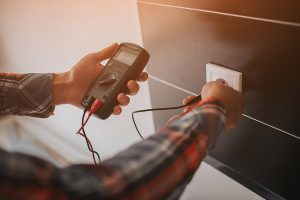How GFCI Outlets Keep Your Kitchen and Bathroom Safe
No matter how safe you try to make your home for your family, there are some inherent dangers. Electricity is one of those dangers. While electricity is a crucial element of your home’s construction, any issue that arises can have serious consequences. With electrical problems, you can face outages, shocks, and even fire. Ground Fault Circuit Interrupter (GFCI) outlets can help remove some of this risk and make sure that your home stays safe for you and your family.

What are GFCI Outlets and How Do They Work?
GFCI outlets are specialty outlets designed to recognize ground faults. Ground faults happen when electricity flows through an unintended path, such as water. The sensors in the outlet will continuously monitor the flow of electricity and any imbalance or leakage in that flow by constantly comparing the amount of electricity entering the circuit with the amount returning. Once they detect a fault, they will immediately cut the power to that outlet to avoid any risk of electric shock, fire, or other hazard. The detected fault can be as little as five milliamps.
Do I Have to Use Them?
Unless you built the home you are currently living in, you probably haven’t given your outlets much thought and may not know if you already have GFCI outlets. It’s actually quite simple to determine which outlets are GFCI. GFCI outlets will have “test” and “reset” buttons on their faceplate, usually located between the two outlets. When the outlet trips, the reset button will pop out, and you will need to press it to reset it. If you’ve ever had to do that, you know you have a GFCI outlet.
If you are building a new home, remodeling, or doing any upgrades that require electrical work, you may wonder if using GFCI outlets is a requirement. In some cases, yes. GFCI outlets are required by building codes to be used in any area where electrical faults are more common, such as kitchens and bathrooms. Yet even if you aren’t required by building code to use GFCI outlets, the safety benefits of reduced electrical damage risk, increased safety for children, and fire prevention make them well worth the low-cost investment. A house with GFCI outlets may also qualify for reduced premiums on homeowner’s insurance, because the risk of electrical damage is significantly less.
Why Kitchens and Bathrooms?
If you look at the building code requirements, GFCI outlets are required in rooms that contain water. Most commonly in:
- Kitchens
- Bathrooms
- Laundry Rooms
- Basements
- Utility Closets
The reasoning for this is very simple. These areas are prone to higher levels of moisture, which increases the risk of electrical damage, shock, or fire. Short circuits that cause damage are often caused by water.
Are There Any Appliances That Can Cause Issues with GFCI Outlets?
While GFCI outlets are often required for kitchens and bathrooms, there are certain appliances that either have built-in protection (such as hair dryers) or are high-powered and can cause false trips because of their high power draw (such as microwaves or refrigerators). These appliances should be on a dedicated circuit to avoid “nuisance tripping”. With a dedicated circuit, false trips can be greatly reduced. A licensed electrician can help you determine which appliances should be on dedicated circuits and the best kind of GFCI outlet to use.
Do GFCI Outlets Need to Be Installed by an Electrician?
Anything involving electricity in your home should be handled by a qualified electrician. No matter how many YouTube tutorials you watch or how easy someone tries to tell you the process is, the majority of homeowners do not have the electrical expertise and experience to safely install GFCI outlets. You don’t want to put your safety at risk by cutting corners.
GFCI outlets are usually an affordable investment, even with professional installation. Unless you have other electrical issues, a qualified electrician will usually be able to do the upgrades in a very short time. One of the benefits of hiring a professional for installation is that you can get a professional opinion on exactly where to install the outlets for maximum safety and code compliance. Your electrician will finish the process by testing each outlet to make sure they are working properly to protect your home.
Recognizing Damage
GFCI outlets are durable and reliable. However, there are signs when they need to be replaced. Even though they are designed for high moisture areas, make sure you are taking every precaution to keep them dry, and make sure they are not overloaded with too many high powered devices, as water and overuse can damage them. Cracks, scorch marks, or frequent trips are usually signs that the outlet has sustained damage and needs to be replaced.
GFCI outlets can help make your home safer for you and your family. With some simple outlet upgrades, you can help protect your home from fire and your family from shocks. If you need an upgrade to GFCI outlets, contact Oakwood Electric & Generator to schedule a service call.